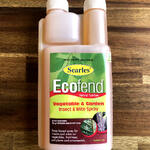-
Filter By Stock
- In Stock (3)
Mealy Bugs
 Mealybugs are an extremely common pest which suck sap from a broad range of plants. There are several different types (eg citrus mealybug, longtailed mealybug) and their feeding causes weakened growth, wilting and foliage distortion. They also produce honeydew which attracts ants and causes sooty mould to develop.
Mealybugs are an extremely common pest which suck sap from a broad range of plants. There are several different types (eg citrus mealybug, longtailed mealybug) and their feeding causes weakened growth, wilting and foliage distortion. They also produce honeydew which attracts ants and causes sooty mould to develop.
Female mealybugs are oval in shape and about 5mm long (at full size). Their bodies may be pale yellow, grey or pink but are covered in a white waxy substance which overall makes them look whitish. Some species have longer filaments growing off their body. Males are tiny and rarely seen. Eggs can be laid singularly or in large clusters covered with a whitey waxy substance that looks a bit like cotton wool. The longtailed mealybug gives birth to live young rather than laying eggs.
Generally the complete life cycle takes 1-3 months with several generations occurring each year. As a result it is common to see all stages on badly infected plants at the same time (eg egg mass, juveniles and adults).
Mealybugs tend to congregate in the moist and protected parts of plants eg in dense foliage, where leaves and stems meet, near buds and growing points, the underside of leaves and places where fruits touch each other or foliage. Some will also invade the soil and attack forming shoots or roots.
Mealybugs are slow moving but are commonly carried about by ants. Ants will actively farm mealybugs to ensure a continuing supply of the sweet honeydew. They also fight off predatory insects which would normally eat mealybugs.
If left untreated mealybug numbers can quickly build up causing leaf drop, reduced vigour and even plant death. The resulting sooty mould is also unsightly and further hinders the plant’s ability to grow as it blocks sunlight to the leaves.
Plants Attacked
Mealybugs attack a very broad range of plants including fruits and vegetables, indoor plants and outdoor ornamentals like annuals, perennials, shrubs, palms and trees.
- control ants by applying a band of horticultural glue or vaseline around the base of plant trunks to restrict their movements.
Overseas Eco-Neem is approved for controlling mealybugs but it is not yet registered in Australia for this pest.

DIATOMACEOUS EARTH
Diatomaceous Earth is a silica rich powdered mineral and is 100% natural and non-toxic. It is made from the fossilised remains of freshwater single-c
From $8.95

DIATOMACEOUS EARTH - POWDER DISPENSER
Heavy duty dispenser used to spray Diatomaceous Earth. Is best used for smaller projects requiring a fine spray. For large jobs, use the DIATOM
$8.95

DIATOMACEOUS EARTH - SHAKER
Heavy duty stainless steel shaker used to sprinkle Diatomaceous Earth. Is best used for small to medium proje
$10.95

NATRASOAP 1L
NatraSoap Insecticidal Soap Spray offers a gentle yet effective way to control soft-bodied pests like mealybugs in your garden or crops. Made from nat
$29.95

ECO-FEND Insect & Mite Spray 1L
Soap based spray for insects and mites on vegetables, fruit trees, pot plants and ornamentals. Soap based spray for insects and mites on vegetables
$45.95
